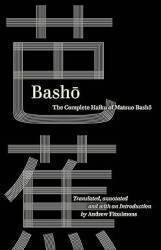
Mount Haguro Path
2,446-Step Path Up Mount Haguro
The path to the top is 1.7 kilometers long,
with 2,446 stone steps climbing about 280 meters of elevation.
The path starts by descending slightly
from the main entry gate to the Suga waterfall,
which is around 140 m elevation.
Then you climb up all these steps to the summit,
which is around 420 m elevation.
Follow the obvious path!
It's a broad stone path with stairs.
Google Maps shows just the first part of it,
and then would send you off on a muddy trail to the side.
I show you below what you can see there,
and you may want to explore,
but pay attention to your surroundings and not your phone.
Founding the Shrine, Building the Path
The shrine on Mount Haguro was established over 1,400 years ago, and the stone path was built about 400 years ago.
More than you care to know about Shugendō, Shintō, Buddhism, and Japanese prehistoryPrince Hachiko was the first-born son of Emperor Sushun, the 32nd Emperor of Japan according to the traditional list. Elements of the Soga clan assassinated the Emperor in 592 CE. Prince Hachiko fled north to these mountains, which were outside the control of the Emperor's government. He is credited with establishing this shrine complex in 593.
There are major shrines on the summits of three mountains — here on Mount Haguro, on Mount Gassan, and on Mount Yudono. The summits of Mount Gassan and Mount Yudono are is at 1,984 and 1,500 meters, respectively. At just 420 meters, Haguro is the only peak open year-round. The other two are only open from late spring to early fall because of the deep snow that covers them.
So, while the Mount Yudono shrine is considered the most holy one, the Mount Haguro shrine is the primary shrine, venerating all three mountains.
The syncretic religion of Shugendō formed during the 7th century CE from a mixture of beliefs and rituals from esoteric Buddhism, which was arriving from China; Shintō, which was evolving out of the kami worship that had arrived from the Korean peninsula over the preceding millennia; and various beliefs and practices surviving from the original late Paleolithic inhabitants of the archipelago. Shugendō incorporated mountain worship, worship of a mountain peak, perhaps personified as some form of deity thought to inhabit it.
En no Ozuno was an ascetic and mystic, based near the Imperial court near today's Nara. He became known as En no Gyōja, "En the Ascetic", carrying out a variety of mountain worship training. Then he was accused of dangerous sorcery, manipulating demonic spirits and so on. The Emperor banished him to Izu Ōshima, an island 22 kilometers off the southern coast of Honshū, in 699 CE. Two years later he was allowed to return.
VisitingKōyasan
En no Gyōja is credited as having founded Shugendō, which became popular among the nobility surrounding the Imperial court. He is listed as one of the prominent figures who visited Mount Haguro soon after Hachiko established the shrine. Another prominent visitor was Kūkai, who founded the Shingon Sect of Esoteric Buddhism at Kōyasan.
So, this shrine was established over a half-century before what's described as the founding of Shugendō. It would originally have been dedicated to the primeval shamanic practices of the Jōmon people who walked from northeastern Asia into northern Japan during the Last Glacial Maximum. The kami worship that was formed into Shintō arrived, along with wet-rice agriculture and the Japonic language family, with the Yayoi people who started crossing from the Korean peninsula to Japan's southern main island of Kyūshū around 1000–700 BCE.
| mid-500s | Buddhism arrives in Japan, from China via Korea — maybe in 538, maybe in 552, neither date is certain, some time during the reign of King Seong of Baekje on the Korean peninsula |
| 592 | Soga clan assassinates Emperor Sushun, Prince Hachiko flees north |
| 593 | Hachiko founds the Mount Haguro shrine |
| 634 | En no Ozuno is born; he became known as En no Gyōja as he studied mystic traditions and magic and founded Shugendō |
| 699–701 | En no Gyōja is exiled to Izu Ōshima, dies within a few years of returning |
| 712 | Kojiki, the first "history" of Japan, mostly a collection of myths, is written |
| 720 | Nihon Shoki, the second purported history of Japan, is written |
| 774–835 | Life of Kūkai, founder of Shingon school of esoteric Buddhism |
| 794 | Heian period begins as Emperor Kammu moves the Imperial court from today's Nara about 40 kilometers north to the newly built Heian-kyō, today's Kyōto |
Ten'yū, the 50th bettō or chief priest of the Three Mountains of Dewa, spent roughly 13 years in the 1600s constructing the 1.7 km path.

Ten'yū and the two chief priests before him — Yūgen, #48; and Yūshen, #49 — planted over 500 cryptomeria or Japanese cedar trees. Many of those are still standing.
Up the Path!
Yes, the path is steep in places. There are three steep segments called Ichino-saka, Nino-saka, and Sanno-saka, or the First Slope, Second Slope, and Third Slope.
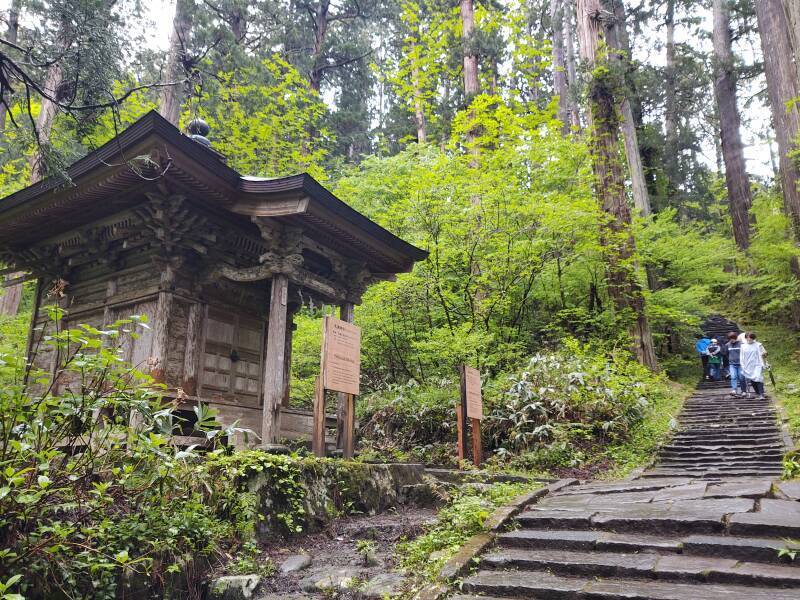
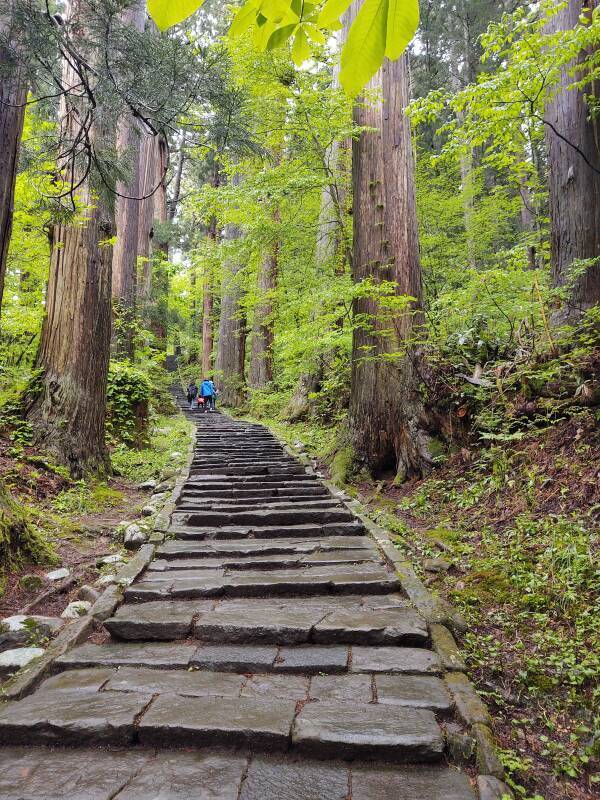

Some stretches are nearly level, but then the steps start again.
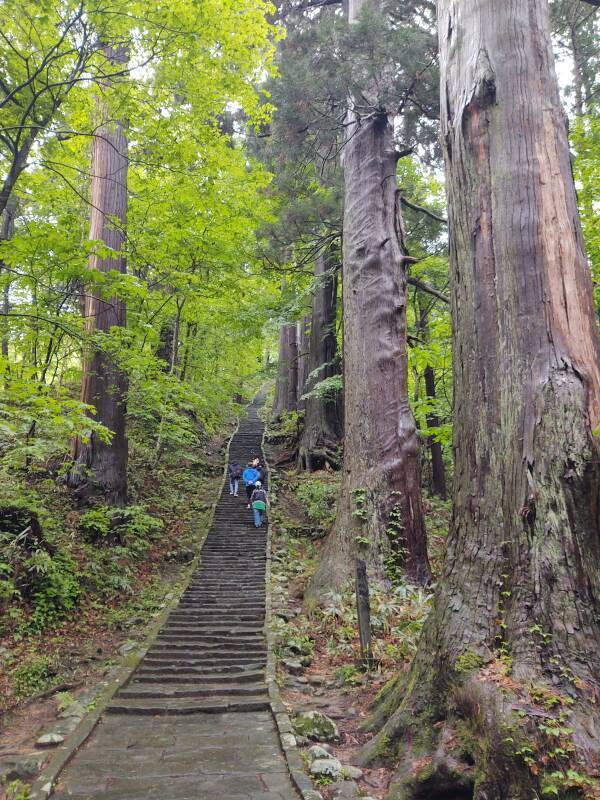
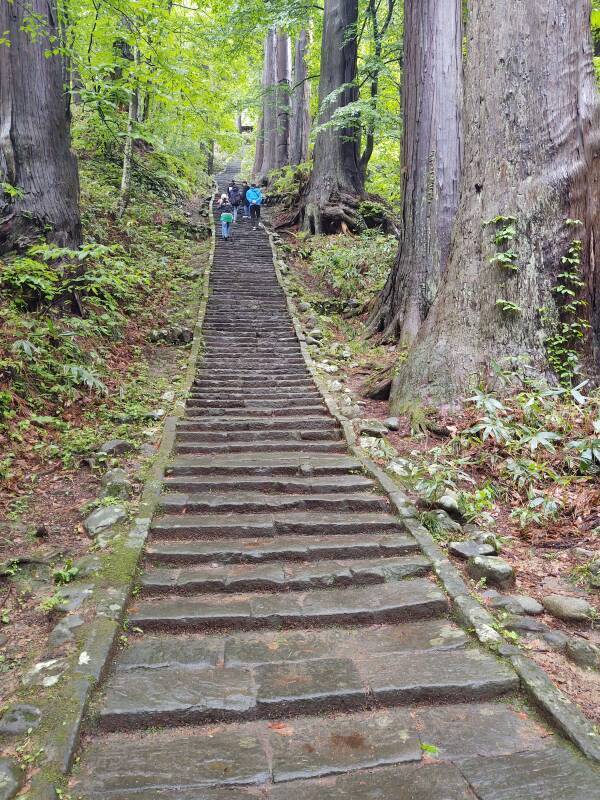
A tea house sits not quite half-way up, around 260 meters elevation. You can see out of the forest over the plain toward Tsuruoka and the coast.
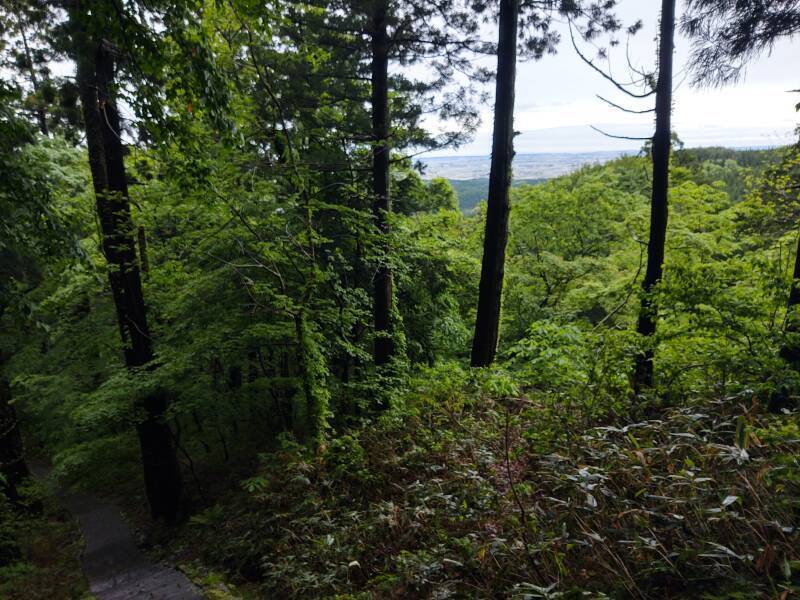
Matsuo Bashō, who lived 1644–1694, was the most famous and popular poet of the time. He is now recognized as the greatest master of the haiku form.
He also wrote acclaimed books documenting his travels throughout Japan.
A monument to Bashō stands along the path near the tea house in one of the more level sections.
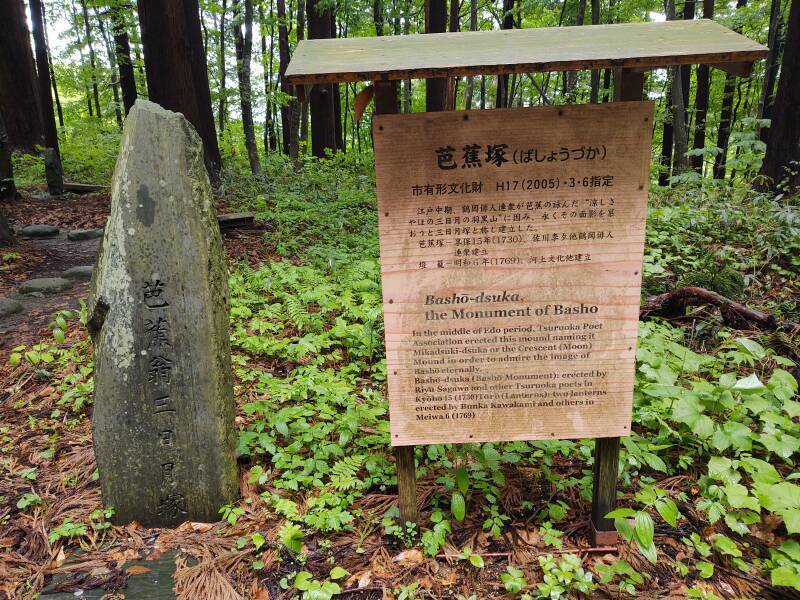
Bashō-dsuka,
the Monument of Bashō
In the middle of the Edo period,
the Tsuruoka Poet Association erected this mound naming it
Mikadsuki-dsuka or the Crescent (Moon) Mount
in order to admire the image of Bashō eternally.
Bashō-dsuka (Bashō Monument):
erected by Riyū Sagawa and other Tsuruoka poets
in Kyōhō 15 (1730).
Tōrō (Lanterns): two lanterns erected
by Bunka Kawakami and others in Meiwa 6 (1769)

Small shrines line the path.
Hie Shrine
Enshrined:
Ōkuninushi no mikoto
Deity of nation building, agriculture, commerce, and medicine
Divine virtue: Matchmaking, conception, conjugal harmony,
medical and industrial development,
protection in sericulture,
transportation,
and navigation
Ōyamakui no kami
Deity of Mount Hiei,
Dharmapala of Tendai-sh#x016b;,
of brewing/distillation
Divine virtue:
Industrial and genealogical prosperity,
brewing/distillation protection
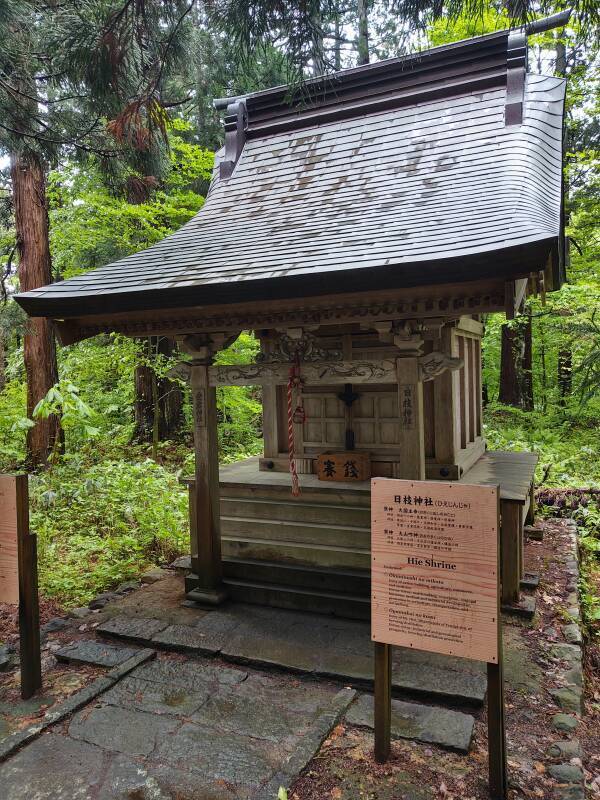
A torii marks the site of the Izanagi Inari Shrine.
Bashō is said to have composed a haiku here.
A less distinct side path leads on to Hagurosan Minamidani and the site of a temple where Bashō is said to have stayed.

Watch out, Google Maps shows that muddy side trail as the main path. Keep climbing on the stone path and steps.


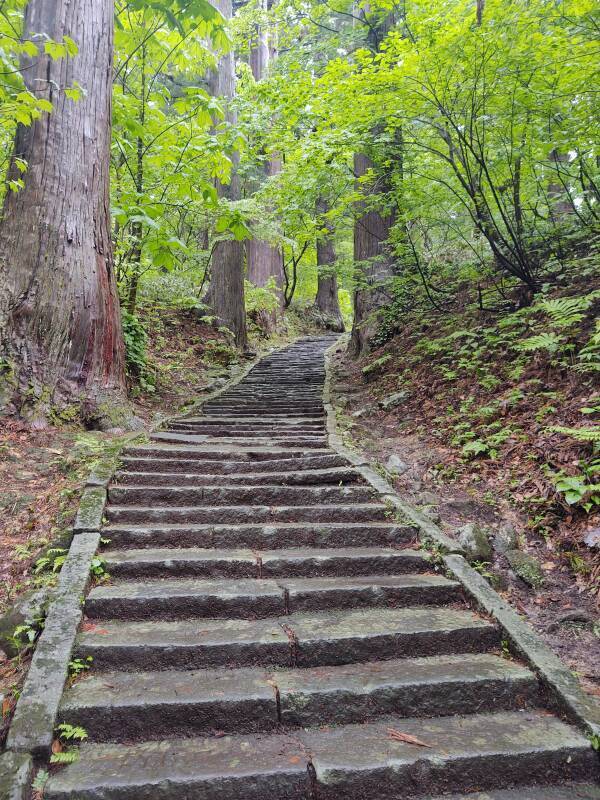

Haniyamahime Shrine
Enshrined:
Haniyamahime no mikoto
Deity of soil, farmland, and porcelain
Divine virtue: farmland reclamation,
pottery, children, safe delivery
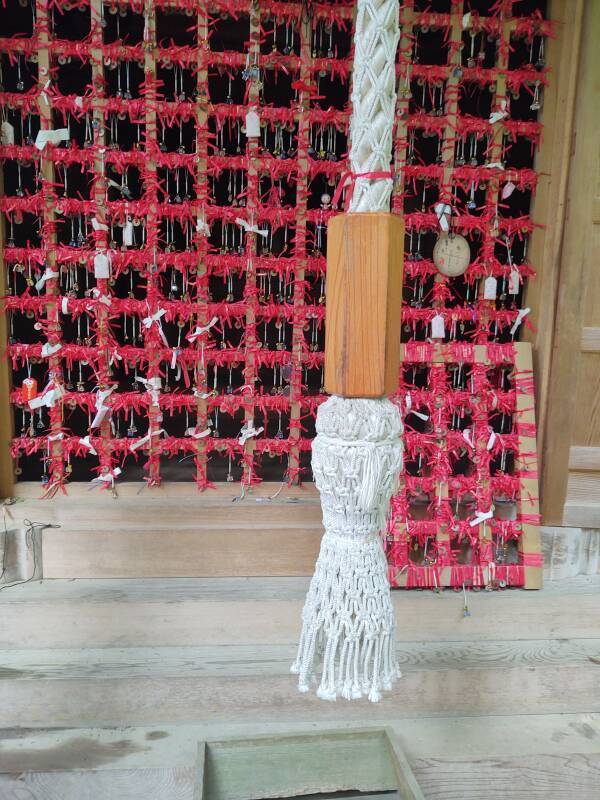

Haniyamahime no mikoto together with Haniyamabiko no mikoto are believed to be deities of marriage.
People who are engaged or newly married cover the shrine doors with charms. Some are in the form of ¥5 and ¥50 coins. They are the two coins with holes, making them more auspicious offerings and also providing a way to hang them on a ribbon.
The shrine's interior is very Shintō, very austere.

The Haniyamahime Shrine is past the half-way point. One last steep segment remains.


In the picture below I was nearing the top of the path and turned to look back down.

You pass the entrance to Saikan about 100 meters before the top of the path.

It was originally a Buddhist temple named Shōn'in, built in 1697. After the Meiji Restoration it was converted to a Shintō pilgrim lodge and its name was changed to Saikan. It focuses on the yamabushi training for Shintō-focused esoteric mountain asceticism.
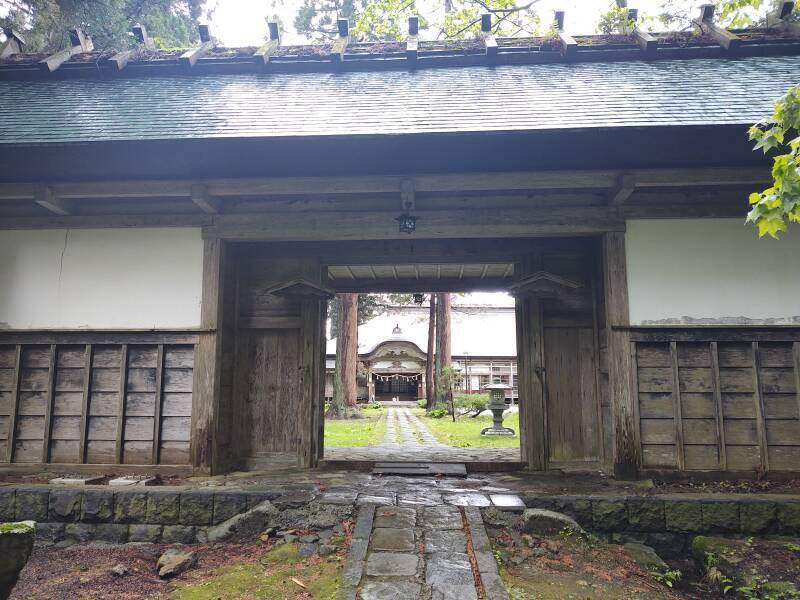
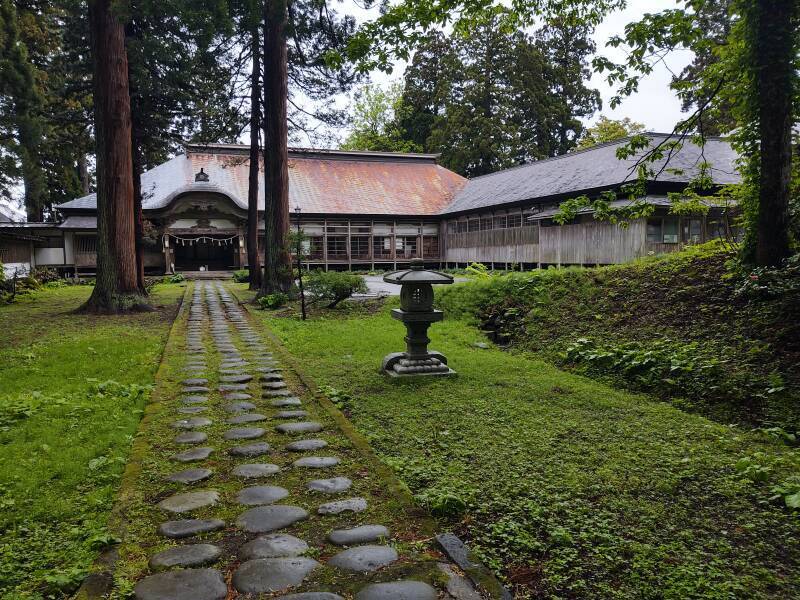
You can stay here if you plan ahead. It's a pilgrim lodge, so baths and toilets are communal. Meals are shojin-ryori by default, strict Buddhist vegetarian. Pescetarian meals, vegetarian plus seafood and eggs like the wonderful meals at my ryokan, are available. If you require vegan cuisine, they say that they can provide it but only if you ask for it three days in advance.
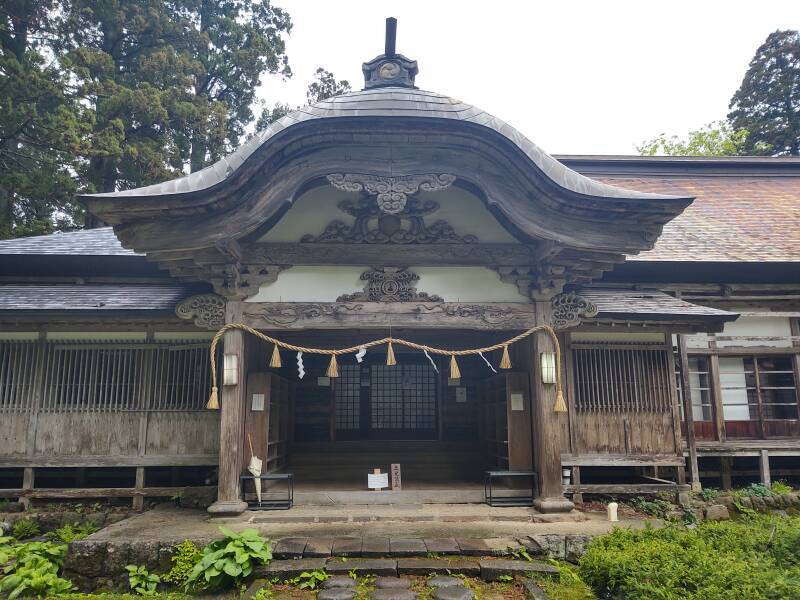
Then it's only about a hundred meters to the large torii at the top of the path, leading you into the Dewasanzan shrine complex.
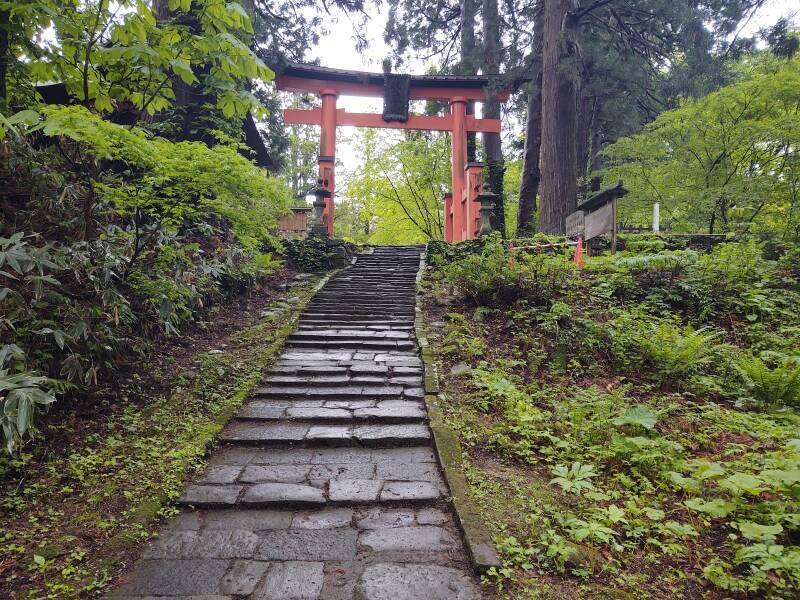

Other topics in Japan:
